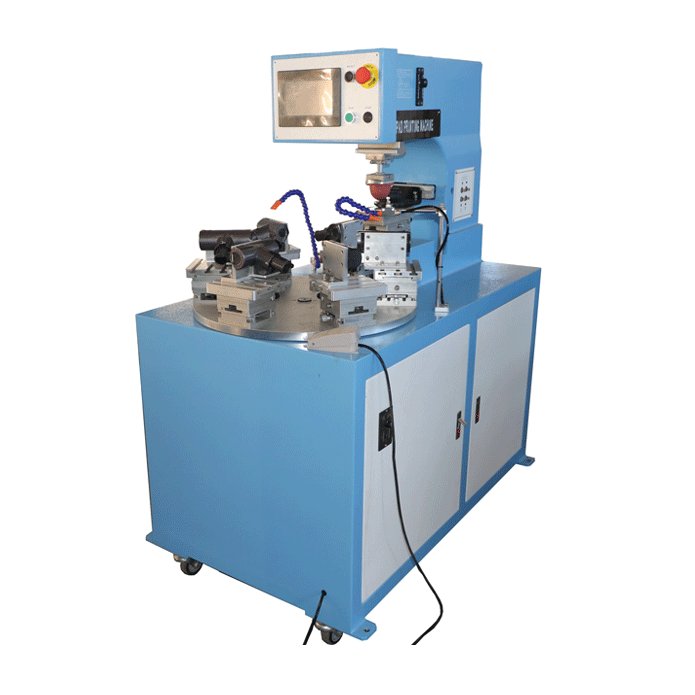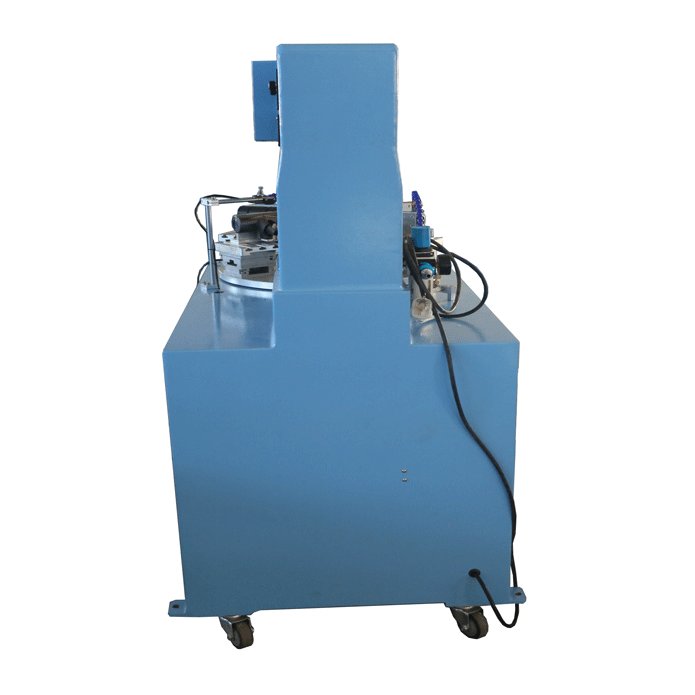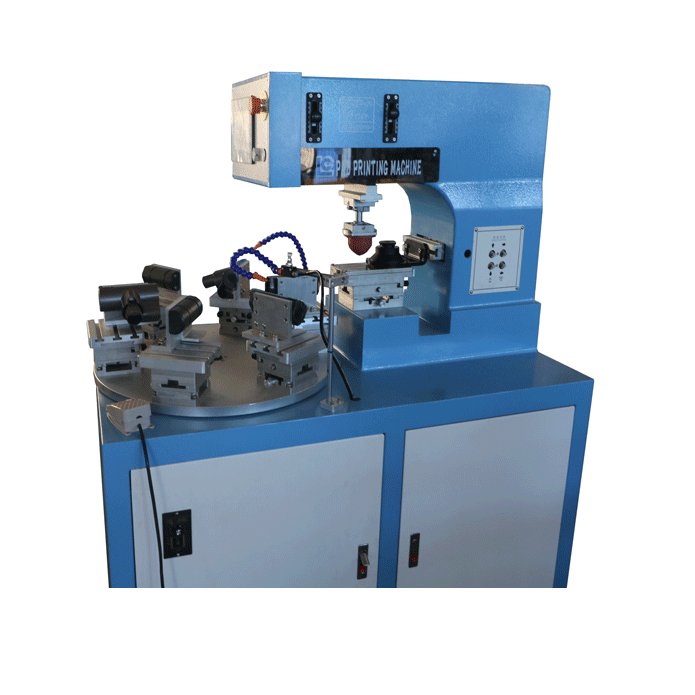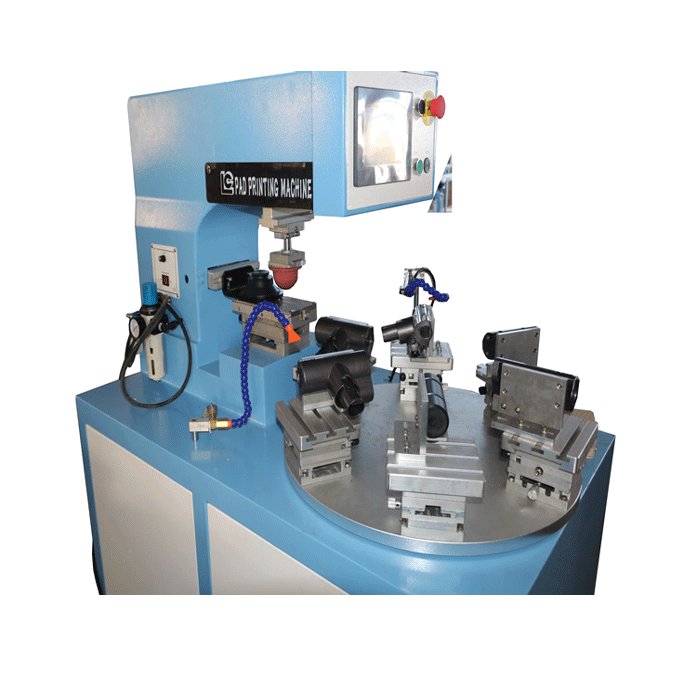Model No.︰P1-200AR4T
Brand Name︰LC
Country of Origin︰China
Unit Price︰US $ 12450 / pc
Minimum Order︰1 pc
1. Four-station turntable
Installing a four-station flat turntable allows different operations to be performed simultaneously or in different working stages. Usually one station is used to place the workpiece to be printed, one station is used for printing operations, and the other stations may be used for loading and unloading workpieces or for simple inspection of printed workpieces.
2. Ink supply with oil cup
• The ink supply system with oil cup can accurately provide ink. The oil cup can store ink well and evenly deliver the ink to the pad printing plate through the internal mechanical structure or pneumatic device. The ink supply with oil cup can better control the amount of ink, reduce ink waste, and make the ink more evenly distributed on the pad printing plate, thereby ensuring the quality and clarity of the printed pattern.
3. Touch screen operation
• Touch screen operation makes the control of the machine more convenient and intuitive. The operator can set various parameters such as printing speed and turntable speed by touching the screen, and it can also be used to control every action of the pad printing machine.
4. Monochrome turntable pad printing machine
The pad printing machine can only print one color at a time. It is more suitable for some workpieces that only need simple color identification or patterns. The turntable structure combined with monochrome printing can efficiently perform continuous monochrome printing on workpieces. When working, the turntable sends the workpieces to the printing station in sequence, and the rubber head after ink supply from the oil cup prints the color on the workpiece, and then the printed workpiece is turned out. The whole process is carried out in an orderly manner under the control of the touch screen.
|
One color pad printer with 4-station conveyer//Structure |
|
|
Working table |
4-station conveyer-type working table |
|
Ink supply system |
90mm diameter Closed cup type system |
|
Plate type and size |
0.3mm Thin steel sheets plate. |
|
Pad dropping control |
Simple-cylinder , Continue pressing |
|
Ink drying |
Heat air |
|
One color pad printer//Usage and characters |
|
|
Guide |
|
|
Application fields |
Electrons, hardware, autos, toys, gifts, Plastics, household appliances, artwork, stationery, adornment, cosmetic, commodity, sport goods, decorative lightings, woodwork, office supplies, Photo Materials, Kitchen utensils, Hotel supplies, Computer, Mobile, etc., industrial field. |
|
One color pad printer with 4-station conveyer//Parameter |
|
|
Technical parameters |
P1-150AR4T simple colour sealed cup pad printer with 4-station conveyer
|
|
Works supply |
|
|
Package list |
|
|
H.S.Code |
8443198000 |
|
Certicate |
CE |
|
One color pad printer with conveyer //Advantage |
|
|
Function |
|
Printing supplies︰
Pad printers target a wide variety of products, with differences in shape and material. Different products have different printing positions and printing effects. Printing engineers must design different printing processes and select different printing consumables according to user needs.
1) Pad printing plates: The plates are made of thick steel plates, thin steel sheets, resin plates, etc. They are used on oil cup pad printers or open pad printers. The printed pattern needs to be etched on the plates. Generally, a single-color pad printer is equipped with one plate, a two-color pad printer is equipped with two plates, and so on.
2) Fixture: The printed product must be fixed on the workbench with a fixture to ensure that the printing position meets the requirements. The fixture can be made of metal or non-metal materials. A single-color pad printer and a shuttle pad printer require a fixture, while a turntable pad printer needs to be equipped with a number of fixtures equal to the number of workstations.
3) Ink: The ink type is selected according to the material of the product, and the ink color is selected according to the printed pattern. Different types of inks should match different pad printing processes. After the ink dries, it should be able to firmly adhere to the product surface. A single-color pad printer uses one color of ink at a time, a four-color pad printer uses four colors of ink, and so on.
4) Pad printing rubber head: Different product shapes and different pad printing patterns require pad printing rubber heads of different shapes. The pad printing rubber head should be able to perfectly achieve the pad printing task and maintain the stability of the properties.
5) Blade or oil cup: Blades are used on open pad printing machines, and oil cups are used on closed pad printing machines. Blades and oil cups should be able to scrape off the ink on the steel plate and should be replaced in time when damaged.




